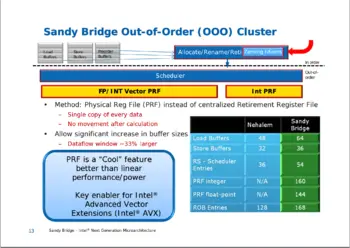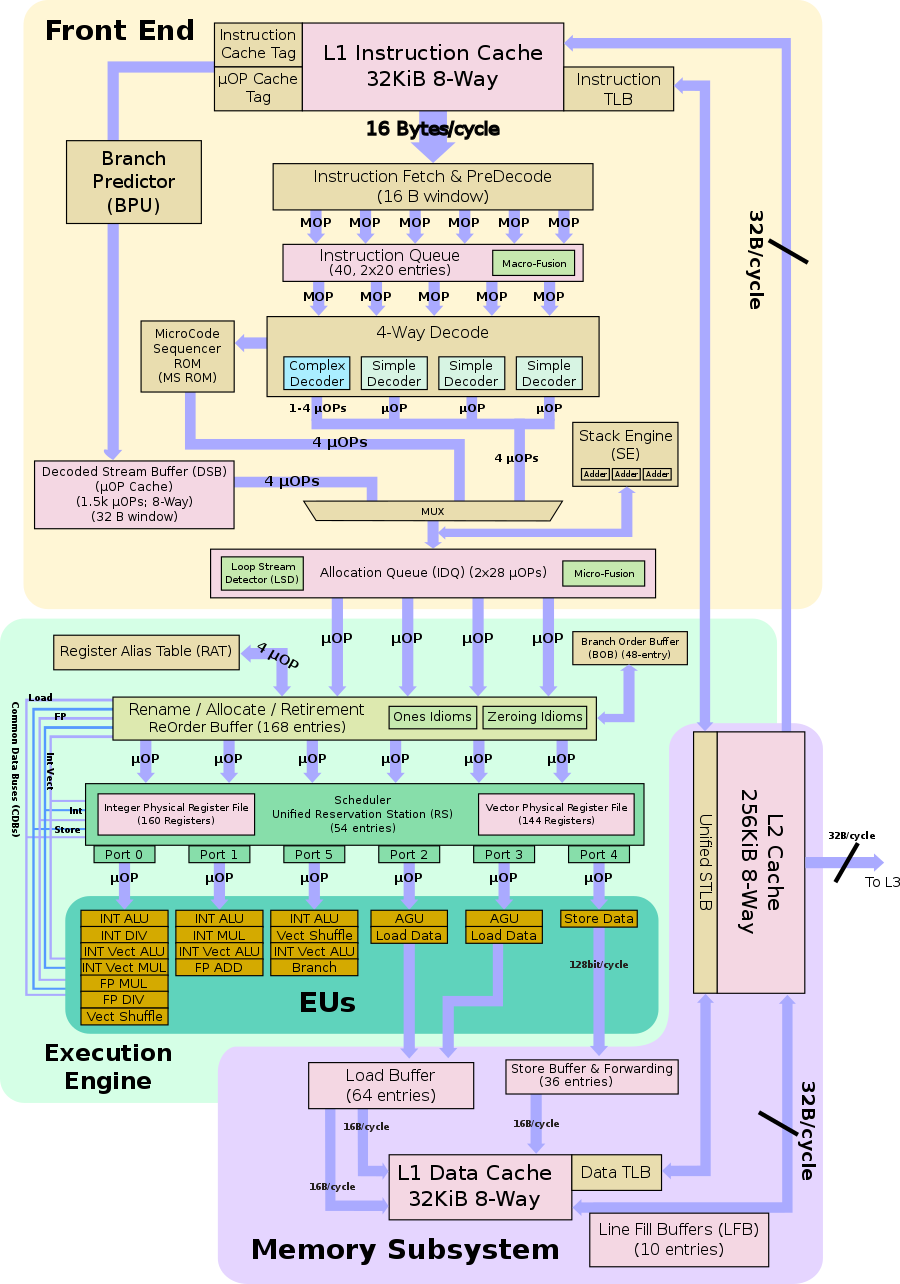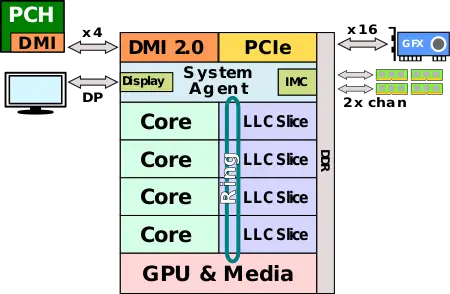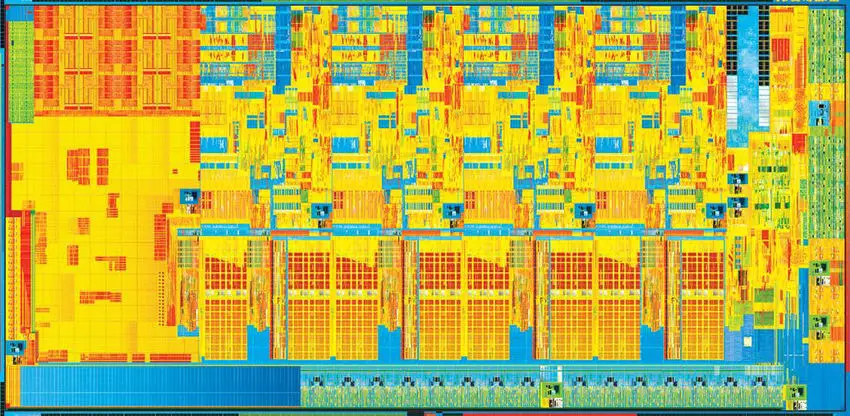| Line 131: | Line 131: | ||
<tr><th colspan="12">Count: {{#ask:[[Category:microprocessor models by intel]][[instance of::microprocessor]][[microarchitecture::Sandy Bridge]]|format=count}}</th></tr> | <tr><th colspan="12">Count: {{#ask:[[Category:microprocessor models by intel]][[instance of::microprocessor]][[microarchitecture::Sandy Bridge]]|format=count}}</th></tr> | ||
</table> | </table> | ||
| + | |||
| + | == References == | ||
| + | * [https://newsroom.intel.com/editorials/sandy-bridge-breaks-the-mold-for-chip-codenames/ Sandy Bridge Breaks the Mold for Chip Codenames], December 29, 2010 | ||
Revision as of 02:52, 26 July 2017
| Edit Values | |
| Sandy Bridge (client) µarch | |
| General Info | |
| Arch Type | CPU |
| Designer | Intel |
| Manufacturer | Intel |
| Introduction | September 13, 2010 |
| Phase-out | November, 2012 |
| Process | 32 nm |
| Core Configs | 2, 4 |
| Pipeline | |
| Type | Superscalar, Superpipeline |
| OoOE | Yes |
| Speculative | Yes |
| Reg Renaming | Yes |
| Stages | 14-19 |
| Decode | 4-way |
| Instructions | |
| ISA | x86-16, x86-32, x86-64 |
| Succession | |
Sandy Bridge (SNB) Client Configuration, formerly Gesher, is Intel's successor to Nehalem, a 32 nm process microarchitecture for mainstream workstations, desktops, and mobile devices. Sandy Bridge is the "Tock" phase as part of Intel's Tick-Tock model which added a significant number of enhancements and features. The microarchitecture was predominantly developed by Intel's R&D center in Haifa, Israel.
For desktop and mobile, Sandy Bridge is branded as 2nd Generation Intel Core i3, Core i5, Core i7 processors. For workstations it's branded as first generation Xeon E3.
Contents
Etymology
Sandy Bridge was originally called Gesher which literally means "bridge" in Hebrew. The name was requested to be changed by upper management after a meeting between the development group and analysts brought up that it might be a bad idea to be associated with a failed political party that was eventually dissolved.
The name Sandy Bridge consists of the English translation of "Gesher" with "Sandy" possible referring to the fact that silicon comes from sand.
The Logo on the left was Intel's original ("Gesher") logo for the microarchitecture.
Codenames
| This section is empty; you can help add the missing info by editing this page. |
Process Technology
- Main article: Westmere § Process Technology
Sandy Bridge uses the same 32 nm process used for the Westmere microarchitecture for all mainstream consumer parts.
Architecture
Sandy Bridge's features an entirely new architecture with a brand new core design which is both more performent and more power efficient. Sandy Bridge provides considerable higher integration verses its predecessors.
Key changes from Westmere
- Entirely brand new microarchitecture
- Chipset
- Ibex Peak → Cougar Point
- Socket H (LGA-1156) → Socket H2 (LGA-1155)
- Integrated Graphics
- Integrated graphics is now integrated on the same die (previously was on a second die)
- Dropped QPI controller which linked the two dies
- IMC
- Integrated on-die is now integrated on the same die (previously was on a second die)
- Dropped QPI controller which linked the two dies
| This section requires expansion; you can help adding the missing info. |
Block Diagram
Individual Core
Overview
Sandy Bridge was an entirely new microarchitecture which combines some of the improvements that were implemented in NetBurst along with the original P6 design. In addition to the new core design, Sandy Bridge took advantage of Intel's 32 nm process which enabled the integration all the components of the chip on a single die, including the integrated graphics and the integrated memory controller. Previously (e.g., Nehalem) the integrated graphics and the memory interface were fabricated on a separate die which was packaged together and communicated over Intel's QuickPath Interconnect (QPI).
Sandy Bridge introduced a number of performance features that brought better-than-linear performance/power as well as a number of enhancements that improved performance while saving power. Intel introduced a number of new vector computation security instructions which improved floating point performance and throughput as well as speedup the throughput of various encryption algorithms.
The block diagram on the right is a complete quad-core Sandy Bridge SoC which integrates the System Agent (SA), the four physical cores, and the integrated graphics. Interconnecting everything is a complex ring on-die which is composed of six agents - one for each core and cache slice, one for the system agent, and one for the graphics. The upper portion of the diagram is the System Agent (SA) which incorporates the display controller, the memory controller, and the various I/O interfaces. Sandy Bridge incorporates 20 PCIe 2.0 lanes - x4 are used by the DMI with the other x16 lanes designed for a dedicated GPU. The memory controller supports up to dual-channel DDR3-1333 (depending on model).
Sandy Bridge integrated four cores (or two for lower end) on die, each including its own last level cache (LLC) slice. Sandy Bridge improves the cache with higher bandwidth and lower power. The individual cores have undergone a total redesign which improved both performance and power.
Core
Sandy Bridge can be considered the first brand new microarchitecture since the introduction of NetBurst and P6 prior. Sandy Bridge went back to the drawing board and incorporated many of beneficial elements from P6 as well as NetBurst. While NetBurst ended up being a seriously flawed architecture, its design was driven by a number of key innovations which were re-implemented and enhanced in Sandy Bridge. This is different from earlier architectures (i.e., Core through Nehalem) which were almost exclusively enhancements of P6 with nothing inherited from P4. Every aspect of the core was improved over its predecessors with very functional block being improved.
| This section requires expansion; you can help adding the missing info. |
Die
Quad-core Sandy Bridge die:
- 1,160,000,000 transistors
- 32 nm process
- 216 mm2
- 4 CPU cores
- 1 GPU core
- 12 EUs
Cores
| This section is empty; you can help add the missing info by editing this page. |
All Sandy Bridge Chips
... further results| Sandy Bridge Chips | |||||||||||
|---|---|---|---|---|---|---|---|---|---|---|---|
| Main processor | IGP | ||||||||||
| Model | µarch | Platform | Core | Launched | SDP | TDP | Freq | Max Mem | Name | Freq | Max Freq |
| 787 | Sandy Bridge | Sandy Bridge M | Sandy Bridge M | July 2011 | 17 W 17,000 mW 0.0228 hp 0.017 kW | 1,300 MHz 1.3 GHz 1,300,000 kHz | 16,384 MiB 16,777,216 KiB 17,179,869,184 B 16 GiB 0.0156 TiB | HD Graphics (Sandy Bridge) | 350 MHz 0.35 GHz 350,000 KHz | 950 MHz 0.95 GHz 950,000 KHz | |
| 797 | Sandy Bridge | Sandy Bridge M | Sandy Bridge M | January 2012 | 17 W 17,000 mW 0.0228 hp 0.017 kW | 1,400 MHz 1.4 GHz 1,400,000 kHz | 16,384 MiB 16,777,216 KiB 17,179,869,184 B 16 GiB 0.0156 TiB | HD Graphics (Sandy Bridge) | 350 MHz 0.35 GHz 350,000 KHz | 950 MHz 0.95 GHz 950,000 KHz | |
| 807 | Sandy Bridge | Sandy Bridge M | Sandy Bridge M | July 2012 | 17 W 17,000 mW 0.0228 hp 0.017 kW | 1,500 MHz 1.5 GHz 1,500,000 kHz | 16,384 MiB 16,777,216 KiB 17,179,869,184 B 16 GiB 0.0156 TiB | HD Graphics (Sandy Bridge) | 350 MHz 0.35 GHz 350,000 KHz | 950 MHz 0.95 GHz 950,000 KHz | |
| 807UE | Sandy Bridge | Sandy Bridge M | Sandy Bridge M | July 2012 | 10 W 10,000 mW 0.0134 hp 0.01 kW | 1,000 MHz 1 GHz 1,000,000 kHz | 4,096 MiB 4,194,304 KiB 4,294,967,296 B 4 GiB 0.00391 TiB | HD Graphics (Sandy Bridge) | 350 MHz 0.35 GHz 350,000 KHz | 800 MHz 0.8 GHz 800,000 KHz | |
| 817 | Sandy Bridge | Sandy Bridge M | Sandy Bridge M | 2012 | 17 W 17,000 mW 0.0228 hp 0.017 kW | 1,600 MHz 1.6 GHz 1,600,000 kHz | 16,384 MiB 16,777,216 KiB 17,179,869,184 B 16 GiB 0.0156 TiB | HD Graphics (Sandy Bridge) | 350 MHz 0.35 GHz 350,000 KHz | 800 MHz 0.8 GHz 800,000 KHz | |
| 827 | Sandy Bridge | Sandy Bridge M | Sandy Bridge M | 2012 | 17 W 17,000 mW 0.0228 hp 0.017 kW | 1,400 MHz 1.4 GHz 1,400,000 kHz | 16,384 MiB 16,777,216 KiB 17,179,869,184 B 16 GiB 0.0156 TiB | HD Graphics (Sandy Bridge) | 350 MHz 0.35 GHz 350,000 KHz | 800 MHz 0.8 GHz 800,000 KHz | |
| 827E | Sandy Bridge | Sandy Bridge M | Sandy Bridge M | July 2011 | 17 W 17,000 mW 0.0228 hp 0.017 kW | 1,400 MHz 1.4 GHz 1,400,000 kHz | 16,384 MiB 16,777,216 KiB 17,179,869,184 B 16 GiB 0.0156 TiB | HD Graphics (Sandy Bridge) | 350 MHz 0.35 GHz 350,000 KHz | 800 MHz 0.8 GHz 800,000 KHz | |
| 837 | Sandy Bridge | Sandy Bridge M | Sandy Bridge M | 2012 | 17 W 17,000 mW 0.0228 hp 0.017 kW | 1,800 MHz 1.8 GHz 1,800,000 kHz | 16,384 MiB 16,777,216 KiB 17,179,869,184 B 16 GiB 0.0156 TiB | HD Graphics (Sandy Bridge) | 350 MHz 0.35 GHz 350,000 KHz | 800 MHz 0.8 GHz 800,000 KHz | |
| 847 | Sandy Bridge | Sandy Bridge M | Sandy Bridge M | June 2011 | 17 W 17,000 mW 0.0228 hp 0.017 kW | 1,100 MHz 1.1 GHz 1,100,000 kHz | 16,384 MiB 16,777,216 KiB 17,179,869,184 B 16 GiB 0.0156 TiB | HD Graphics (Sandy Bridge) | 350 MHz 0.35 GHz 350,000 KHz | 800 MHz 0.8 GHz 800,000 KHz | |
| 847E | Sandy Bridge | Sandy Bridge M | Sandy Bridge M | June 2011 | 17 W 17,000 mW 0.0228 hp 0.017 kW | 1,100 MHz 1.1 GHz 1,100,000 kHz | 16,384 MiB 16,777,216 KiB 17,179,869,184 B 16 GiB 0.0156 TiB | HD Graphics (Sandy Bridge) | 350 MHz 0.35 GHz 350,000 KHz | 800 MHz 0.8 GHz 800,000 KHz | |
| 857 | Sandy Bridge | Sandy Bridge M | Sandy Bridge M | July 2011 | 17 W 17,000 mW 0.0228 hp 0.017 kW | 1,200 MHz 1.2 GHz 1,200,000 kHz | 16,384 MiB 16,777,216 KiB 17,179,869,184 B 16 GiB 0.0156 TiB | HD Graphics (Sandy Bridge) | 350 MHz 0.35 GHz 350,000 KHz | 1,000 MHz 1 GHz 1,000,000 KHz | |
| 867 | Sandy Bridge | Sandy Bridge M | Sandy Bridge M | January 2012 | 17 W 17,000 mW 0.0228 hp 0.017 kW | 1,300 MHz 1.3 GHz 1,300,000 kHz | 16,384 MiB 16,777,216 KiB 17,179,869,184 B 16 GiB 0.0156 TiB | HD Graphics (Sandy Bridge) | 350 MHz 0.35 GHz 350,000 KHz | 1,000 MHz 1 GHz 1,000,000 KHz | |
| 877 | Sandy Bridge | Sandy Bridge M | Sandy Bridge M | July 2012 | 17 W 17,000 mW 0.0228 hp 0.017 kW | 1,400 MHz 1.4 GHz 1,400,000 kHz | 16,384 MiB 16,777,216 KiB 17,179,869,184 B 16 GiB 0.0156 TiB | HD Graphics (Sandy Bridge) | 350 MHz 0.35 GHz 350,000 KHz | 1,000 MHz 1 GHz 1,000,000 KHz | |
| 887 | Sandy Bridge | Sandy Bridge M | Sandy Bridge M | September 2012 | 17 W 17,000 mW 0.0228 hp 0.017 kW | 1,500 MHz 1.5 GHz 1,500,000 kHz | 16,384 MiB 16,777,216 KiB 17,179,869,184 B 16 GiB 0.0156 TiB | HD Graphics (Sandy Bridge) | 350 MHz 0.35 GHz 350,000 KHz | 1,000 MHz 1 GHz 1,000,000 KHz | |
| 887E | Sandy Bridge | Sandy Bridge M | Sandy Bridge M | September 2012 | 17 W 17,000 mW 0.0228 hp 0.017 kW | 1,500 MHz 1.5 GHz 1,500,000 kHz | 16,384 MiB 16,777,216 KiB 17,179,869,184 B 16 GiB 0.0156 TiB | HD Graphics (Sandy Bridge) | 350 MHz 0.35 GHz 350,000 KHz | 1,000 MHz 1 GHz 1,000,000 KHz | |
| 897 | Sandy Bridge | Sandy Bridge M | Sandy Bridge M | 2012 | 17 W 17,000 mW 0.0228 hp 0.017 kW | 1,600 MHz 1.6 GHz 1,600,000 kHz | 16,384 MiB 16,777,216 KiB 17,179,869,184 B 16 GiB 0.0156 TiB | HD Graphics (Sandy Bridge) | 350 MHz 0.35 GHz 350,000 KHz | 1,000 MHz 1 GHz 1,000,000 KHz | |
| B710 | Sandy Bridge | Sandy Bridge M | Sandy Bridge M | June 2011 | 35 W 35,000 mW 0.0469 hp 0.035 kW | 1,600 MHz 1.6 GHz 1,600,000 kHz | 16,384 MiB 16,777,216 KiB 17,179,869,184 B 16 GiB 0.0156 TiB | HD Graphics (Sandy Bridge) | 650 MHz 0.65 GHz 650,000 KHz | 1,000 MHz 1 GHz 1,000,000 KHz | |
| B720 | Sandy Bridge | Sandy Bridge M | Sandy Bridge M | January 2012 | 35 W 35,000 mW 0.0469 hp 0.035 kW | 1,700 MHz 1.7 GHz 1,700,000 kHz | 16,384 MiB 16,777,216 KiB 17,179,869,184 B 16 GiB 0.0156 TiB | HD Graphics (Sandy Bridge) | 650 MHz 0.65 GHz 650,000 KHz | 1,000 MHz 1 GHz 1,000,000 KHz | |
| B730 | Sandy Bridge | Sandy Bridge M | Sandy Bridge M | July 2012 | 35 W 35,000 mW 0.0469 hp 0.035 kW | 1,800 MHz 1.8 GHz 1,800,000 kHz | 16,384 MiB 16,777,216 KiB 17,179,869,184 B 16 GiB 0.0156 TiB | HD Graphics (Sandy Bridge) | 650 MHz 0.65 GHz 650,000 KHz | 1,000 MHz 1 GHz 1,000,000 KHz | |
| B800 | Sandy Bridge | Sandy Bridge M | Sandy Bridge M | June 2011 | 35 W 35,000 mW 0.0469 hp 0.035 kW | 1,500 MHz 1.5 GHz 1,500,000 kHz | 16,384 MiB 16,777,216 KiB 17,179,869,184 B 16 GiB 0.0156 TiB | HD Graphics (Sandy Bridge) | 650 MHz 0.65 GHz 650,000 KHz | 1,000 MHz 1 GHz 1,000,000 KHz | |
| B810 | Sandy Bridge | Sandy Bridge M | Sandy Bridge M | 14 March 2011 | 35 W 35,000 mW 0.0469 hp 0.035 kW | 1,600 MHz 1.6 GHz 1,600,000 kHz | 16,384 MiB 16,777,216 KiB 17,179,869,184 B 16 GiB 0.0156 TiB | HD Graphics (Sandy Bridge) | 650 MHz 0.65 GHz 650,000 KHz | 950 MHz 0.95 GHz 950,000 KHz | |
| B810E | Sandy Bridge | Sandy Bridge M | Sandy Bridge M | June 2011 | 35 W 35,000 mW 0.0469 hp 0.035 kW | 1,600 MHz 1.6 GHz 1,600,000 kHz | 16,384 MiB 16,777,216 KiB 17,179,869,184 B 16 GiB 0.0156 TiB | HD Graphics (Sandy Bridge) | 650 MHz 0.65 GHz 650,000 KHz | 1,000 MHz 1 GHz 1,000,000 KHz | |
| B815 | Sandy Bridge | Sandy Bridge M | Sandy Bridge M | January 2012 | 35 W 35,000 mW 0.0469 hp 0.035 kW | 1,600 MHz 1.6 GHz 1,600,000 kHz | 16,384 MiB 16,777,216 KiB 17,179,869,184 B 16 GiB 0.0156 TiB | HD Graphics (Sandy Bridge) | 650 MHz 0.65 GHz 650,000 KHz | 1,050 MHz 1.05 GHz 1,050,000 KHz | |
| B820 | Sandy Bridge | Sandy Bridge M | Sandy Bridge M | July 2012 | 35 W 35,000 mW 0.0469 hp 0.035 kW | 1,700 MHz 1.7 GHz 1,700,000 kHz | 16,384 MiB 16,777,216 KiB 17,179,869,184 B 16 GiB 0.0156 TiB | HD Graphics (Sandy Bridge) | 650 MHz 0.65 GHz 650,000 KHz | 1,050 MHz 1.05 GHz 1,050,000 KHz | |
| B830 | Sandy Bridge | Sandy Bridge M | Sandy Bridge M | July 2011 | 35 W 35,000 mW 0.0469 hp 0.035 kW | 1,800 MHz 1.8 GHz 1,800,000 kHz | 16,384 MiB 16,777,216 KiB 17,179,869,184 B 16 GiB 0.0156 TiB | HD Graphics (Sandy Bridge) | 650 MHz 0.65 GHz 650,000 KHz | 1,050 MHz 1.05 GHz 1,050,000 KHz | |
| B840 | Sandy Bridge | Sandy Bridge M | Sandy Bridge M | July 2011 | 35 W 35,000 mW 0.0469 hp 0.035 kW | 1,900 MHz 1.9 GHz 1,900,000 kHz | 16,384 MiB 16,777,216 KiB 17,179,869,184 B 16 GiB 0.0156 TiB | HD Graphics (Sandy Bridge) | 650 MHz 0.65 GHz 650,000 KHz | 1,000 MHz 1 GHz 1,000,000 KHz | |
| B860E | Sandy Bridge | Sandy Bridge M | Sandy Bridge M | 2012 | 35 W 35,000 mW 0.0469 hp 0.035 kW | 2,100 MHz 2.1 GHz 2,100,000 kHz | 16,384 MiB 16,777,216 KiB 17,179,869,184 B 16 GiB 0.0156 TiB | HD Graphics (Sandy Bridge) | 650 MHz 0.65 GHz 650,000 KHz | 1,000 MHz 1 GHz 1,000,000 KHz | |
| i3-2308M | Sandy Bridge | Sandy Bridge M | Sandy Bridge M | February 2011 | 35 W 35,000 mW 0.0469 hp 0.035 kW | 2,100 MHz 2.1 GHz 2,100,000 kHz | 16,384 MiB 16,777,216 KiB 17,179,869,184 B 16 GiB 0.0156 TiB | HD Graphics 3000 | 650 MHz 0.65 GHz 650,000 KHz | 1,100 MHz 1.1 GHz 1,100,000 KHz | |
| i3-2310E | Sandy Bridge | Sandy Bridge M | Sandy Bridge M | February 2011 | 35 W 35,000 mW 0.0469 hp 0.035 kW | 2,100 MHz 2.1 GHz 2,100,000 kHz | 16,384 MiB 16,777,216 KiB 17,179,869,184 B 16 GiB 0.0156 TiB | HD Graphics 3000 | 650 MHz 0.65 GHz 650,000 KHz | 1,050 MHz 1.05 GHz 1,050,000 KHz | |
| i3-2310M | Sandy Bridge | Sandy Bridge M | Sandy Bridge M | February 2011 | 35 W 35,000 mW 0.0469 hp 0.035 kW | 2,100 MHz 2.1 GHz 2,100,000 kHz | 16,384 MiB 16,777,216 KiB 17,179,869,184 B 16 GiB 0.0156 TiB | HD Graphics 3000 | 650 MHz 0.65 GHz 650,000 KHz | 1,100 MHz 1.1 GHz 1,100,000 KHz | |
| i3-2312M | Sandy Bridge | Sandy Bridge M | Sandy Bridge M | June 2011 | 35 W 35,000 mW 0.0469 hp 0.035 kW | 2,100 MHz 2.1 GHz 2,100,000 kHz | 16,384 MiB 16,777,216 KiB 17,179,869,184 B 16 GiB 0.0156 TiB | HD Graphics 3000 | 650 MHz 0.65 GHz 650,000 KHz | 1,100 MHz 1.1 GHz 1,100,000 KHz | |
| i3-2328M | Sandy Bridge | Sandy Bridge M | Sandy Bridge M | September 2012 | 35 W 35,000 mW 0.0469 hp 0.035 kW | 2,200 MHz 2.2 GHz 2,200,000 kHz | 16,384 MiB 16,777,216 KiB 17,179,869,184 B 16 GiB 0.0156 TiB | HD Graphics 3000 | 650 MHz 0.65 GHz 650,000 KHz | 1,100 MHz 1.1 GHz 1,100,000 KHz | |
| i3-2330E | Sandy Bridge | Sandy Bridge M | Sandy Bridge M | June 2011 | 35 W 35,000 mW 0.0469 hp 0.035 kW | 2,200 MHz 2.2 GHz 2,200,000 kHz | 16,384 MiB 16,777,216 KiB 17,179,869,184 B 16 GiB 0.0156 TiB | HD Graphics 3000 | 650 MHz 0.65 GHz 650,000 KHz | 1,050 MHz 1.05 GHz 1,050,000 KHz | |
| i3-2330M | Sandy Bridge | Sandy Bridge M | Sandy Bridge M | June 2011 | 35 W 35,000 mW 0.0469 hp 0.035 kW | 2,200 MHz 2.2 GHz 2,200,000 kHz | 16,384 MiB 16,777,216 KiB 17,179,869,184 B 16 GiB 0.0156 TiB | HD Graphics 3000 | 650 MHz 0.65 GHz 650,000 KHz | 1,100 MHz 1.1 GHz 1,100,000 KHz | |
| i3-2332M | Sandy Bridge | Sandy Bridge M | Sandy Bridge M | September 2011 | 35 W 35,000 mW 0.0469 hp 0.035 kW | 2,200 MHz 2.2 GHz 2,200,000 kHz | 16,384 MiB 16,777,216 KiB 17,179,869,184 B 16 GiB 0.0156 TiB | HD Graphics 3000 | 650 MHz 0.65 GHz 650,000 KHz | 1,100 MHz 1.1 GHz 1,100,000 KHz | |
| i3-2340UE | Sandy Bridge | Sandy Bridge M | Sandy Bridge M | June 2011 | 17 W 17,000 mW 0.0228 hp 0.017 kW | 1,300 MHz 1.3 GHz 1,300,000 kHz | 16,384 MiB 16,777,216 KiB 17,179,869,184 B 16 GiB 0.0156 TiB | HD Graphics 3000 | 350 MHz 0.35 GHz 350,000 KHz | 800 MHz 0.8 GHz 800,000 KHz | |
| i3-2348M | Sandy Bridge | Sandy Bridge M | Sandy Bridge M | January 2013 | 35 W 35,000 mW 0.0469 hp 0.035 kW | 2,300 MHz 2.3 GHz 2,300,000 kHz | 16,384 MiB 16,777,216 KiB 17,179,869,184 B 16 GiB 0.0156 TiB | HD Graphics 3000 | 650 MHz 0.65 GHz 650,000 KHz | 1,150 MHz 1.15 GHz 1,150,000 KHz | |
| i3-2350LM | Sandy Bridge | Sandy Bridge M | Sandy Bridge M | October 2011 | 17 W 17,000 mW 0.0228 hp 0.017 kW | 1,600 MHz 1.6 GHz 1,600,000 kHz | 16,384 MiB 16,777,216 KiB 17,179,869,184 B 16 GiB 0.0156 TiB | HD Graphics 3000 | 650 MHz 0.65 GHz 650,000 KHz | 1,150 MHz 1.15 GHz 1,150,000 KHz | |
| i3-2350M | Sandy Bridge | Sandy Bridge M | Sandy Bridge M | October 2011 | 35 W 35,000 mW 0.0469 hp 0.035 kW | 2,300 MHz 2.3 GHz 2,300,000 kHz | 16,384 MiB 16,777,216 KiB 17,179,869,184 B 16 GiB 0.0156 TiB | HD Graphics 3000 | 650 MHz 0.65 GHz 650,000 KHz | 1,150 MHz 1.15 GHz 1,150,000 KHz | |
| i3-2355M | Sandy Bridge | Sandy Bridge M | Sandy Bridge M | 2012 | 17 W 17,000 mW 0.0228 hp 0.017 kW | 1,300 MHz 1.3 GHz 1,300,000 kHz | 16,384 MiB 16,777,216 KiB 17,179,869,184 B 16 GiB 0.0156 TiB | HD Graphics 3000 | 350 MHz 0.35 GHz 350,000 KHz | 1,000 MHz 1 GHz 1,000,000 KHz | |
| i3-2357M | Sandy Bridge | Sandy Bridge M | Sandy Bridge M | June 2011 | 17 W 17,000 mW 0.0228 hp 0.017 kW | 1,300 MHz 1.3 GHz 1,300,000 kHz | 16,384 MiB 16,777,216 KiB 17,179,869,184 B 16 GiB 0.0156 TiB | HD Graphics 3000 | 350 MHz 0.35 GHz 350,000 KHz | 950 MHz 0.95 GHz 950,000 KHz | |
| i3-2365M | Sandy Bridge | Sandy Bridge M | Sandy Bridge M | September 2012 | 17 W 17,000 mW 0.0228 hp 0.017 kW | 1,400 MHz 1.4 GHz 1,400,000 kHz | 16,384 MiB 16,777,216 KiB 17,179,869,184 B 16 GiB 0.0156 TiB | HD Graphics 3000 | 350 MHz 0.35 GHz 350,000 KHz | 1,000 MHz 1 GHz 1,000,000 KHz | |
| i3-2367M | Sandy Bridge | Sandy Bridge M | Sandy Bridge M | October 2011 | 17 W 17,000 mW 0.0228 hp 0.017 kW | 1,400 MHz 1.4 GHz 1,400,000 kHz | 16,384 MiB 16,777,216 KiB 17,179,869,184 B 16 GiB 0.0156 TiB | HD Graphics 3000 | 350 MHz 0.35 GHz 350,000 KHz | 1,000 MHz 1 GHz 1,000,000 KHz | |
| i3-2370LM | Sandy Bridge | Sandy Bridge M | Sandy Bridge M | 2012 | 17 W 17,000 mW 0.0228 hp 0.017 kW | 1,700 MHz 1.7 GHz 1,700,000 kHz | 16,384 MiB 16,777,216 KiB 17,179,869,184 B 16 GiB 0.0156 TiB | HD Graphics 3000 | 650 MHz 0.65 GHz 650,000 KHz | 1,150 MHz 1.15 GHz 1,150,000 KHz | |
| i3-2370M | Sandy Bridge | Sandy Bridge M | Sandy Bridge M | January 2012 | 35 W 35,000 mW 0.0469 hp 0.035 kW | 2,400 MHz 2.4 GHz 2,400,000 kHz | 16,384 MiB 16,777,216 KiB 17,179,869,184 B 16 GiB 0.0156 TiB | HD Graphics 3000 | 650 MHz 0.65 GHz 650,000 KHz | 1,150 MHz 1.15 GHz 1,150,000 KHz | |
| i3-2375M | Sandy Bridge | Sandy Bridge M | Sandy Bridge M | January 2013 | 17 W 17,000 mW 0.0228 hp 0.017 kW | 1,500 MHz 1.5 GHz 1,500,000 kHz | 16,384 MiB 16,777,216 KiB 17,179,869,184 B 16 GiB 0.0156 TiB | HD Graphics 3000 | 350 MHz 0.35 GHz 350,000 KHz | 1,000 MHz 1 GHz 1,000,000 KHz | |
| i3-2377M | Sandy Bridge | Sandy Bridge M | Sandy Bridge M | September 2012 | 17 W 17,000 mW 0.0228 hp 0.017 kW | 1,500 MHz 1.5 GHz 1,500,000 kHz | 16,384 MiB 16,777,216 KiB 17,179,869,184 B 16 GiB 0.0156 TiB | HD Graphics 3000 | 350 MHz 0.35 GHz 350,000 KHz | 1,000 MHz 1 GHz 1,000,000 KHz | |
| i3-2390M | Sandy Bridge | Sandy Bridge M | Sandy Bridge M | 2012 | 35 W 35,000 mW 0.0469 hp 0.035 kW | 2,500 MHz 2.5 GHz 2,500,000 kHz | 16,384 MiB 16,777,216 KiB 17,179,869,184 B 16 GiB 0.0156 TiB | HD Graphics 3000 | 650 MHz 0.65 GHz 650,000 KHz | 1,150 MHz 1.15 GHz 1,150,000 KHz | |
| i3-2393M | Sandy Bridge | Sandy Bridge M | Sandy Bridge M | 14 August 2011 | 35 W 35,000 mW 0.0469 hp 0.035 kW | 2,500 MHz 2.5 GHz 2,500,000 kHz | 16,384 MiB 16,777,216 KiB 17,179,869,184 B 16 GiB 0.0156 TiB | HD Graphics 3000 | 650 MHz 0.65 GHz 650,000 KHz | 1,100 MHz 1.1 GHz 1,100,000 KHz | |
| i3-2394M | Sandy Bridge | Sandy Bridge M | Sandy Bridge M | October 2011 | 35 W 35,000 mW 0.0469 hp 0.035 kW | 2,600 MHz 2.6 GHz 2,600,000 kHz | 16,384 MiB 16,777,216 KiB 17,179,869,184 B 16 GiB 0.0156 TiB | HD Graphics 3000 | 650 MHz 0.65 GHz 650,000 KHz | 1,100 MHz 1.1 GHz 1,100,000 KHz | |
| Count: 122 | |||||||||||
References
- Sandy Bridge Breaks the Mold for Chip Codenames, December 29, 2010
| codename | Sandy Bridge (client) + |
| core count | 2 + and 4 + |
| designer | Intel + |
| first launched | September 13, 2010 + |
| full page name | intel/microarchitectures/sandy bridge (client) + |
| instance of | microarchitecture + |
| instruction set architecture | x86-16 +, x86-32 + and x86-64 + |
| manufacturer | Intel + |
| microarchitecture type | CPU + |
| name | Sandy Bridge (client) + |
| phase-out | November 2012 + |
| pipeline stages (max) | 19 + |
| pipeline stages (min) | 14 + |
| process | 32 nm (0.032 μm, 3.2e-5 mm) + |






